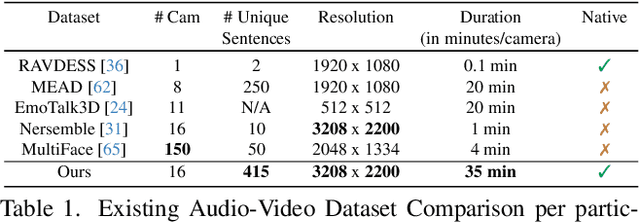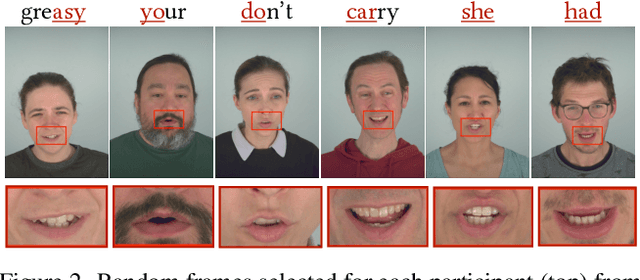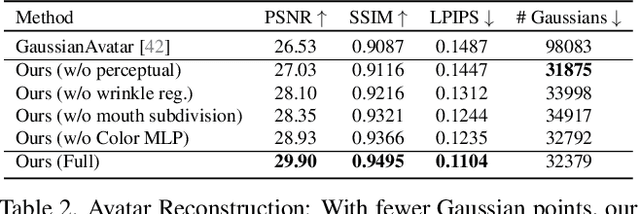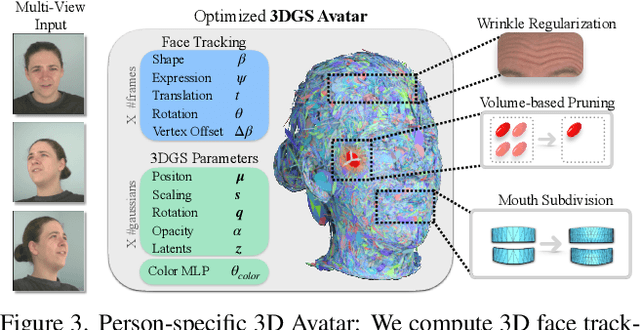Tobias Kirschstein
3DGH: 3D Head Generation with Composable Hair and Face
Jun 25, 2025Abstract:We present 3DGH, an unconditional generative model for 3D human heads with composable hair and face components. Unlike previous work that entangles the modeling of hair and face, we propose to separate them using a novel data representation with template-based 3D Gaussian Splatting, in which deformable hair geometry is introduced to capture the geometric variations across different hairstyles. Based on this data representation, we design a 3D GAN-based architecture with dual generators and employ a cross-attention mechanism to model the inherent correlation between hair and face. The model is trained on synthetic renderings using carefully designed objectives to stabilize training and facilitate hair-face separation. We conduct extensive experiments to validate the design choice of 3DGH, and evaluate it both qualitatively and quantitatively by comparing with several state-of-the-art 3D GAN methods, demonstrating its effectiveness in unconditional full-head image synthesis and composable 3D hairstyle editing. More details will be available on our project page: https://c-he.github.io/projects/3dgh/.
Pixel3DMM: Versatile Screen-Space Priors for Single-Image 3D Face Reconstruction
May 01, 2025Abstract:We address the 3D reconstruction of human faces from a single RGB image. To this end, we propose Pixel3DMM, a set of highly-generalized vision transformers which predict per-pixel geometric cues in order to constrain the optimization of a 3D morphable face model (3DMM). We exploit the latent features of the DINO foundation model, and introduce a tailored surface normal and uv-coordinate prediction head. We train our model by registering three high-quality 3D face datasets against the FLAME mesh topology, which results in a total of over 1,000 identities and 976K images. For 3D face reconstruction, we propose a FLAME fitting opitmization that solves for the 3DMM parameters from the uv-coordinate and normal estimates. To evaluate our method, we introduce a new benchmark for single-image face reconstruction, which features high diversity facial expressions, viewing angles, and ethnicities. Crucially, our benchmark is the first to evaluate both posed and neutral facial geometry. Ultimately, our method outperforms the most competitive baselines by over 15% in terms of geometric accuracy for posed facial expressions.
Avat3r: Large Animatable Gaussian Reconstruction Model for High-fidelity 3D Head Avatars
Feb 27, 2025Abstract:Traditionally, creating photo-realistic 3D head avatars requires a studio-level multi-view capture setup and expensive optimization during test-time, limiting the use of digital human doubles to the VFX industry or offline renderings. To address this shortcoming, we present Avat3r, which regresses a high-quality and animatable 3D head avatar from just a few input images, vastly reducing compute requirements during inference. More specifically, we make Large Reconstruction Models animatable and learn a powerful prior over 3D human heads from a large multi-view video dataset. For better 3D head reconstructions, we employ position maps from DUSt3R and generalized feature maps from the human foundation model Sapiens. To animate the 3D head, our key discovery is that simple cross-attention to an expression code is already sufficient. Finally, we increase robustness by feeding input images with different expressions to our model during training, enabling the reconstruction of 3D head avatars from inconsistent inputs, e.g., an imperfect phone capture with accidental movement, or frames from a monocular video. We compare Avat3r with current state-of-the-art methods for few-input and single-input scenarios, and find that our method has a competitive advantage in both tasks. Finally, we demonstrate the wide applicability of our proposed model, creating 3D head avatars from images of different sources, smartphone captures, single images, and even out-of-domain inputs like antique busts. Project website: https://tobias-kirschstein.github.io/avat3r/
GAF: Gaussian Avatar Reconstruction from Monocular Videos via Multi-view Diffusion
Dec 13, 2024



Abstract:We propose a novel approach for reconstructing animatable 3D Gaussian avatars from monocular videos captured by commodity devices like smartphones. Photorealistic 3D head avatar reconstruction from such recordings is challenging due to limited observations, which leaves unobserved regions under-constrained and can lead to artifacts in novel views. To address this problem, we introduce a multi-view head diffusion model, leveraging its priors to fill in missing regions and ensure view consistency in Gaussian splatting renderings. To enable precise viewpoint control, we use normal maps rendered from FLAME-based head reconstruction, which provides pixel-aligned inductive biases. We also condition the diffusion model on VAE features extracted from the input image to preserve details of facial identity and appearance. For Gaussian avatar reconstruction, we distill multi-view diffusion priors by using iteratively denoised images as pseudo-ground truths, effectively mitigating over-saturation issues. To further improve photorealism, we apply latent upsampling to refine the denoised latent before decoding it into an image. We evaluate our method on the NeRSemble dataset, showing that GAF outperforms the previous state-of-the-art methods in novel view synthesis by a 5.34\% higher SSIM score. Furthermore, we demonstrate higher-fidelity avatar reconstructions from monocular videos captured on commodity devices.
GaussianSpeech: Audio-Driven Gaussian Avatars
Nov 27, 2024



Abstract:We introduce GaussianSpeech, a novel approach that synthesizes high-fidelity animation sequences of photo-realistic, personalized 3D human head avatars from spoken audio. To capture the expressive, detailed nature of human heads, including skin furrowing and finer-scale facial movements, we propose to couple speech signal with 3D Gaussian splatting to create realistic, temporally coherent motion sequences. We propose a compact and efficient 3DGS-based avatar representation that generates expression-dependent color and leverages wrinkle- and perceptually-based losses to synthesize facial details, including wrinkles that occur with different expressions. To enable sequence modeling of 3D Gaussian splats with audio, we devise an audio-conditioned transformer model capable of extracting lip and expression features directly from audio input. Due to the absence of high-quality datasets of talking humans in correspondence with audio, we captured a new large-scale multi-view dataset of audio-visual sequences of talking humans with native English accents and diverse facial geometry. GaussianSpeech consistently achieves state-of-the-art performance with visually natural motion at real time rendering rates, while encompassing diverse facial expressions and styles.
GGHead: Fast and Generalizable 3D Gaussian Heads
Jun 13, 2024Abstract:Learning 3D head priors from large 2D image collections is an important step towards high-quality 3D-aware human modeling. A core requirement is an efficient architecture that scales well to large-scale datasets and large image resolutions. Unfortunately, existing 3D GANs struggle to scale to generate samples at high resolutions due to their relatively slow train and render speeds, and typically have to rely on 2D superresolution networks at the expense of global 3D consistency. To address these challenges, we propose Generative Gaussian Heads (GGHead), which adopts the recent 3D Gaussian Splatting representation within a 3D GAN framework. To generate a 3D representation, we employ a powerful 2D CNN generator to predict Gaussian attributes in the UV space of a template head mesh. This way, GGHead exploits the regularity of the template's UV layout, substantially facilitating the challenging task of predicting an unstructured set of 3D Gaussians. We further improve the geometric fidelity of the generated 3D representations with a novel total variation loss on rendered UV coordinates. Intuitively, this regularization encourages that neighboring rendered pixels should stem from neighboring Gaussians in the template's UV space. Taken together, our pipeline can efficiently generate 3D heads trained only from single-view 2D image observations. Our proposed framework matches the quality of existing 3D head GANs on FFHQ while being both substantially faster and fully 3D consistent. As a result, we demonstrate real-time generation and rendering of high-quality 3D-consistent heads at $1024^2$ resolution for the first time.
NPGA: Neural Parametric Gaussian Avatars
May 29, 2024



Abstract:The creation of high-fidelity, digital versions of human heads is an important stepping stone in the process of further integrating virtual components into our everyday lives. Constructing such avatars is a challenging research problem, due to a high demand for photo-realism and real-time rendering performance. In this work, we propose Neural Parametric Gaussian Avatars (NPGA), a data-driven approach to create high-fidelity, controllable avatars from multi-view video recordings. We build our method around 3D Gaussian Splatting for its highly efficient rendering and to inherit the topological flexibility of point clouds. In contrast to previous work, we condition our avatars' dynamics on the rich expression space of neural parametric head models (NPHM), instead of mesh-based 3DMMs. To this end, we distill the backward deformation field of our underlying NPHM into forward deformations which are compatible with rasterization-based rendering. All remaining fine-scale, expression-dependent details are learned from the multi-view videos. To increase the representational capacity of our avatars, we augment the canonical Gaussian point cloud using per-primitive latent features which govern its dynamic behavior. To regularize this increased dynamic expressivity, we propose Laplacian terms on the latent features and predicted dynamics. We evaluate our method on the public NeRSemble dataset, demonstrating that NPGA significantly outperforms the previous state-of-the-art avatars on the self-reenactment task by 2.6 PSNR. Furthermore, we demonstrate accurate animation capabilities from real-world monocular videos.
MonoNPHM: Dynamic Head Reconstruction from Monocular Videos
Dec 11, 2023



Abstract:We present Monocular Neural Parametric Head Models (MonoNPHM) for dynamic 3D head reconstructions from monocular RGB videos. To this end, we propose a latent appearance space that parameterizes a texture field on top of a neural parametric model. We constrain predicted color values to be correlated with the underlying geometry such that gradients from RGB effectively influence latent geometry codes during inverse rendering. To increase the representational capacity of our expression space, we augment our backward deformation field with hyper-dimensions, thus improving color and geometry representation in topologically challenging expressions. Using MonoNPHM as a learned prior, we approach the task of 3D head reconstruction using signed distance field based volumetric rendering. By numerically inverting our backward deformation field, we incorporated a landmark loss using facial anchor points that are closely tied to our canonical geometry representation. To evaluate the task of dynamic face reconstruction from monocular RGB videos we record 20 challenging Kinect sequences under casual conditions. MonoNPHM outperforms all baselines with a significant margin, and makes an important step towards easily accessible neural parametric face models through RGB tracking.
GaussianAvatars: Photorealistic Head Avatars with Rigged 3D Gaussians
Dec 04, 2023



Abstract:We introduce GaussianAvatars, a new method to create photorealistic head avatars that are fully controllable in terms of expression, pose, and viewpoint. The core idea is a dynamic 3D representation based on 3D Gaussian splats that are rigged to a parametric morphable face model. This combination facilitates photorealistic rendering while allowing for precise animation control via the underlying parametric model, e.g., through expression transfer from a driving sequence or by manually changing the morphable model parameters. We parameterize each splat by a local coordinate frame of a triangle and optimize for explicit displacement offset to obtain a more accurate geometric representation. During avatar reconstruction, we jointly optimize for the morphable model parameters and Gaussian splat parameters in an end-to-end fashion. We demonstrate the animation capabilities of our photorealistic avatar in several challenging scenarios. For instance, we show reenactments from a driving video, where our method outperforms existing works by a significant margin.
DiffusionAvatars: Deferred Diffusion for High-fidelity 3D Head Avatars
Nov 30, 2023Abstract:DiffusionAvatars synthesizes a high-fidelity 3D head avatar of a person, offering intuitive control over both pose and expression. We propose a diffusion-based neural renderer that leverages generic 2D priors to produce compelling images of faces. For coarse guidance of the expression and head pose, we render a neural parametric head model (NPHM) from the target viewpoint, which acts as a proxy geometry of the person. Additionally, to enhance the modeling of intricate facial expressions, we condition DiffusionAvatars directly on the expression codes obtained from NPHM via cross-attention. Finally, to synthesize consistent surface details across different viewpoints and expressions, we rig learnable spatial features to the head's surface via TriPlane lookup in NPHM's canonical space. We train DiffusionAvatars on RGB videos and corresponding tracked NPHM meshes of a person and test the obtained avatars in both self-reenactment and animation scenarios. Our experiments demonstrate that DiffusionAvatars generates temporally consistent and visually appealing videos for novel poses and expressions of a person, outperforming existing approaches.
 Add to Chrome
Add to Chrome Add to Firefox
Add to Firefox Add to Edge
Add to Edge